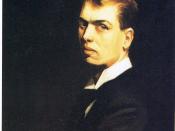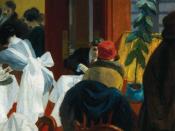The Blind Field is an essay by Margaret Iverson which attempts to explain feelings of nostalgia versus feelings of the uncanny, Freud explained this as distorted repressed memories. These two feelings are virtually opposite. The author goes on to match these feelings with paintings by Hopper. These images were customarilly percieved as being nostalgic, yet she tries to pin feelings of the uncanny to these images. Her defintion of uncanny is a repressed memory that violently breaches the tranqulity of the present. She states that any image can be related to an ominous and distorted memory, hence allowing it to surface.
The first example is "House by the Railroad" by Hopper. It was commonly described as a nostolgic look back to simpler times. In opposition to this view, Iverson states that in our rootless society, an image such as this is a catalyst for repressed memory. She explains that she has never seen such a dark house in such bright light.
The house is viewed from a perspective of a passerby and it presents a fleeting image that is parrallel to fleeting memeories of the mind. Iverson relates to this piece not as a pleasant memory, but as an forboding presence akin to the personality of the house in the movie Psycho.
Hopper also used voids of space in many of his paintings. Iverson equates this to the idea of Thanatos, which is our death drive. This element is thought to induce feelings of fulfillment through destruction and morbidity. In understanding this theory, we are enabled to understand the reason why Hopper's art instills feelings of sinister or mistrust. The blackness also represents the fear of the unknown and the uncertainty of impending future, such as the piece titled " Auto- mat" . The subject stares...


